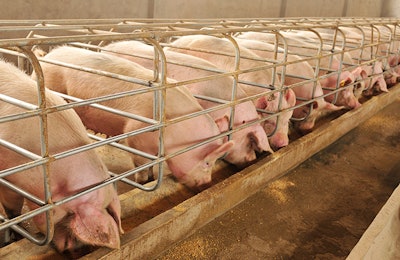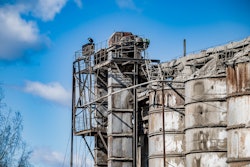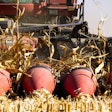
In the grain industry, pest control is widely considered a necessary expense to prevent stored commodity damage and shrink. Most managers quantify insect damage only in terms of the visible consequences, like weight loss and rejected loads.
But what if integrated pest management (IPM) was reframed as an investment in ensuring grain’s nutritional value rather than just an operational cost? According to Johnny Wilson, technical service for Central Life Sciences, this represents a fundamental shift for grain facilities — taking the argument from the traditional “bugs are bad” to a quantifiable business case based on economic and nutritional data.
When insect infestations strike grain storage facilities, the rejected shipments and dockage at delivery only tell half the story. Behind the scenes, considerably more damage could be unfolding.
Even at seemingly modest infestation rates, a typical flour mill, for example, could face annual losses of $100,000, and up to $800,000 when additional processing requirements are factored in.
“Figures like this put (the loss) in relevant terms other than, ‘Insects are bad. You should do something,’” Wilson said. “It shows the industry where the real value of pest management lies.”
A growing body of research also reveals that insects don’t simply consume grain — they strategically eat specific components, substantially altering nutritional profiles long before visible damage is apparent.
This hidden nutritional alteration ripples through animal feed formulation and human food production, creating cascading costs that remain largely invisible until they hit the bottom line.
From grain processing facilities to nutritionists’ formulations, understanding this aspect of insect infestation gives decision-makers a better idea of expected outcomes rather than simply hoping for the best when accepting lower-quality grain.
The science behind nutrient loss
The relationship between insects and grain goes beyond simple consumption. Research findings show the strategic nature of insect feeding, with selective patterns targeting the most valuable nutritional components.
“They are going after those carbohydrates and fats first,” Wilson said.
This creates deceptive analytical results that can mislead nutritionists.
“You don’t see much loss in protein and at some of the levels you actually see an increase in protein,” Wilson said. “But it’s not actually an increase. You're analyzing a smaller sample, but the protein level is staying the same because they’re not going after it. It looks boosted when, in reality, you need to compare that protein value back to the dry matter in the beginning.”
This nuanced understanding comes from rigorous scientific investigation. "Measuring the nutritional cost of insect infestation of stored maize and cowpea," a 2019 study from the University of Greenwich in London examined corn at different infestation levels, measuring protein, carbohydrate, fiber and total energy values.
The findings revealed that at just 5% insect-damaged kernels — the threshold where many buyers begin imposing dockage — grains already suffer over 2% dry matter loss. The more concerning discovery was the disproportionate loss of certain nutrients, especially those critical for energy value.
The research established correlations between initial weight, percentage of damaged grains and specific nutrient losses. These relationships follow predictable patterns that can be modeled mathematically, allowing for accurate prediction of nutritional degradation based on visible damage levels.
Though conducted on specific varieties in the United Kingdom, Wilson confirmed the model’s accuracy when applied to U.S. grain samples.
Translating nutritional damage to economic impact
For animal feed producers, this translates directly to bottom-line costs. In swine production especially, these hidden losses require costly compensation.
“In the swine world, energy is king,” Wilson said. “That’s really what nutritionists are chasing and what they’re formulating based off of.”
When insect damage reduces the metabolizable energy in corn, nutritionists must supplement with expensive additives to maintain performance. This is where a seemingly good bargain becomes a financial drain.
“If my energy is 10% low in that corn and I have to add in 35 more pounds of fat into every ton, I know exactly what that 35 pounds of fat or choice white grease is going to cost,” Wilson said. “We got a $5 a ton dock on this corn, but we just spent $15 by adding lost fat back.”
A recent wheat milling yield trial conducted by Dr. Jeff Gwirtz, adjunct faculty member at Kansas State University’s Department of Grain Science and Industry, developed a financial model to illustrate how seemingly small losses from insect infestation compound throughout the production process of flour mills.
“You have a quarter percent loss here, a half a percent loss there, and by the time you get to the end of it, just after 60 days, you're looking at almost 2% loss,” Wilson said. "That's huge when you put it into context. The (trial involved) essentially building a fictional flour mill with a designated production capacity that is stereotypical in the industry. Even at very low infestation rates, there was a $100,000 loss.”
After accounting for additional screening and blending requirements to address quality issues, the financial loss increased to $800,000, according to the trial data. These economic figures provide decision-makers with concrete justification for taking preventive pest control measures in terms of return on investment at grain facilities.
The economics of preventive pest management
Grain facility operators face constant pressure to cut costs, but the evidence from research makes a case for maintaining — or even strengthening — IPM strategies. The financial impact and nutritional costs of hidden insect damage far outweigh the expense of preventing insect infestation, according to Wilson.
“The best action is prevention in these cases, and if you can stop that population from getting established, it's going to be much easier and cheaper to deal with from the beginning," Wilson said.
A preventive approach includes simple measures like treating empty bins, equipment and even pallets. While these steps are easy, they’re often overlooked, despite their significant impact on preventing costly infestations.
Fundamental IPM practices include:
- Thorough cleaning of empty bins and facilities
- Treatment of empty storage areas before filling
- Inspecting incoming grain for infestation
- Regular monitoring during storage
- Proper chemical rotation for treatments
The long-term financial view
In times of economic pressure, pest management may arise as an area to cut costs.
"The first thing companies do when they get into a financial bind is cut costs,” Wilson said. “But this is one area that if you cut it, you may save 5 cents and lose $15.”
Wilson pointed to historical examples where cost-cutting measures ultimately led to greater expenses.
“In 2007 and 2008, when the grain markets got really tough, people started letting their maintenance workers go, and a year or two years later, they ended up spending a lot more money,” Wilson said. “You've eliminated a position and saved $100,000, and now you’re staring down the barrel of a $500,000 loss due to the amount of grain that went spoiled and was lost."
The financial case for IPM is ultimately about making informed plans based on complete information and not just gut decisions.
Challenges to IPM implementation
Despite the clear case for a robust IPM strategy, grain processing facilities face numerous obstacles to implementation. Wilson acknowledged these real-world constraints, noting that labor shortages often present the first significant hurdle.
"Having a production background, labor's going to be one of the most strained points in a production operation and you're devoting manpower to something that's not actively making money," Wilson said.
This challenge is particularly clear during critical periods like harvest, when allocating staff to thorough cleaning and preventive measures competes directly with processing demands.
Facility conditions represent another major challenge, as Wilson pointed out the differences between modern and older facilities.
“One facility that’s only a couple years old is pristine and then just down the road a sister facility could be 60 years old with an aeration system that doesn't work and hasn't for years," Wilson said.
These varying conditions require different approaches and expectations, making standardized protocols difficult to implement across operations.
Production pressures further complicate IPM implementation, as feed manufacturers face the constant need to keep operations running.
"The worst thing you can do is reject all of your raw ingredients, and then you're not running at all,” Wilson said.
This reality forces facilities to accept certain levels of infestation rather than reject incoming grain entirely, creating a difficult balancing act between quality standards and operational needs.
The communication triangle: Breaking down silos
Perhaps most significantly, Wilson highlighted the communication gaps between key departments as a fundamental barrier to effective IPM.
 Courtesy Central Life Sciences
Courtesy Central Life Sciences
However, reality often falls short.
“More often than not, procurement is dictating what nutrition has to work with and nutrition is dictating what the mills have to make their feed with," he said.
 Courtesy Central Life Sciences
Courtesy Central Life Sciences
The challenge extends to connecting technical IPM knowledge with financial decision-making. Those responsible for day-to-day pest management may understand the problems, but struggle to communicate the financial implications effectively to decision-makers who control budgets.
“Depending on your organization structure, it might not be the most efficient reporting chain to the people that actually make the financial calls," Wilson said.
Bridging this gap requires translating technical information about insect damage into clear financial terms that resonate with leaders across different organizational departments, creating a shared understanding of IPM's value beyond simply eliminating pests.

















